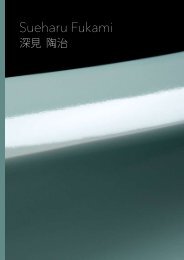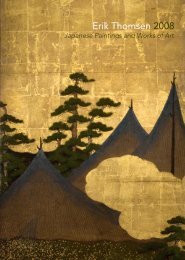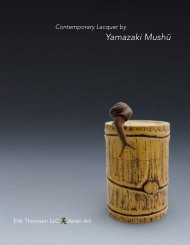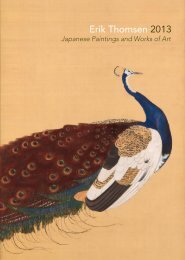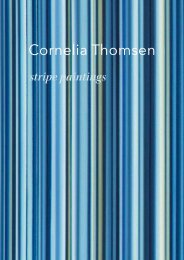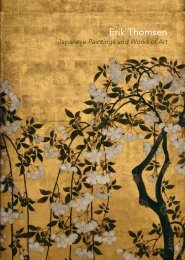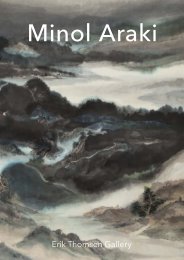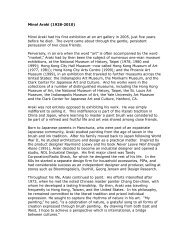View publication (pdf file 6.5 mb) - Erik Thomsen
View publication (pdf file 6.5 mb) - Erik Thomsen
View publication (pdf file 6.5 mb) - Erik Thomsen
- No tags were found...
You also want an ePaper? Increase the reach of your titles
YUMPU automatically turns print PDFs into web optimized ePapers that Google loves.
29Zōhiko Studio 象 彦Tales of Genji Tebako BoxMeiji Period (1868 –1912), circa 1900H 4 ¼" × L 8 ¾" × W 7 ¼"(11 cm × 22 cm × 18.5 cm)Maki-e lacquer boxInscription on top of box: »Tales of Genji« 源 氏 物 語Inventory label on the inside cover:»Reference no. 817. Tebako in the Form of GenjiBooks. Collection of the Zōhiko Country Pavilion«Inscription on storage box: »Tebako box in theshape of books, ex collection of the Zōhiko CountryPavilion« 冊 子 形 蒔 絵 手 箱 象 彦 山 荘 旧 蔵This outstanding rectangular tebako box simulatesa bound volume of the eleventh-century novel TheTales of Genji. The books are realistically renderedwith fine lines of silver lacquer to simulate individualsheets of paper as well as with a fine mosaicof mother-of-pearl and kirigane gold foil inlays ona togidashi gold lacquer ground to simulate thebook binding.The spectacular book cover, which appears to holdthe seven book volumes together, is decoratedwith alternating rectangles of shishi and dragonsin takamakie raised gold lacquer on a togidashilacquer ground. The title »Tales of Genji« 源 氏 物 語is written in takamakie gold lacquer on the coveron a gold and red lacquer togidashi ground with inlaysof small kirigane gold foil squares. The goldlacquer label is especially remarkable as it not onlyreplicates the calligraphy of the title, »The Tales ofGenji«, but also successfully replicates the complexdyed-paper slip on which the title seems to havebeen written.Additional details in this quest for realism are theremarkable mother-of-pearl clasps that seem tokeep the book cover together. The bottom and theinside of the box are decorated with dense nashijigold flakes and the inside cover bears an old inventorylabel from the Zōhiko studio.The Zōhiko Studios is one of the oldest lacquerhouses of Japan. Presently under the leadership ofthe ninth-generation Nishimura Hikobei 西 村 彦 兵 衞(1931–), the house was established in the year 1661as the Zōgeya 象 牙 屋 . 1 The present lacquer boxwas in the storage of the studio for a long time andhad been used as a reference model for creatingother objects.The tebako comes with a black-lacquered fitted boxthat bears an inscribed collector’s mark on the end.98 99



